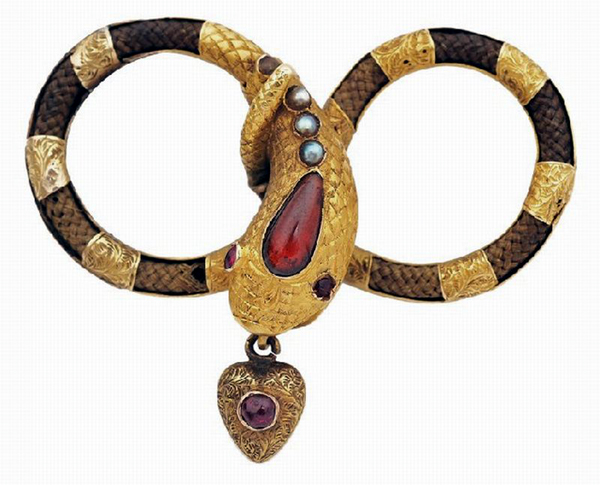Learn about antiques and collectables...
Click on a category below to show all the entries for that category.
Learn about and understand the items, manufacturers, designers and periods as well as the specialist terms used in describing antiques and collectables. Either click one of the letters below to list the items beginning with that letter, or click on a category on the left side of the screen to list the items under that category.
mourning jewellery
In Victorian England there were strict protocols for mourning the death of a family member, relative or (in the case of servants) an employer of employer's family member. They were particularly observed by the upper classes, but followed by other classes where the apparel and accoutrements could be afforded.
Mourning protocols were mainly applied to women, who were expected to wear heavy, concealing, black clothing, together with a black crepe veil, and a cap or bonnet.
Mourning jewellery completed the ensemble.
For a widow, there were three stages of mourning, covering a period of two years or more. The first period of mourning, lasting for a year and a day, was known as "full mourning". "Second mourning" covered a period of nine months, and allowed for a slight relaxation on the colour and style of garments worn, and for mourning jewellery. "Half mourning" lasted from three to six months and more elaborate and coloured fabrics such as grey and lavender could be slowly introduced.
Different rules applied to men, children and servants, depending upon their relationship with the deceased.
When Queen Victoria’s husband, Prince Albert, died of typhoid in 1861, the Queen went into mourning, and continued mourning for the next forty years. She remained in full mourning for the first three years and dressed her entire court that way. The Victorian era reflected the Queen’s prudish ethics as well as, most visibly, her personal taste in mourning.
Although mourning jewellery predates the Victorian era, most antique mourning jewellery available in the marketplace is from the Victorian era.
One of the most popular materials used for the manufacture of mourning jewellery from the mid 19th century to the 1920s was a semi-precious black gemstone called jet. Jet was used to make traditional mourning jewellery such as watch-fobs, necklaces, rings, clasps and brooches.
The industry in producing jet jewellery was centred at the town of Whitby in North Yorkshire, where it was either collected from the beach or excavated at a number of inland locations in the North York Moors area.
The Whitby jet industry was at it's height in 1870s where it has been reported that approximately 1,500 men were employed in some 200 manufacturing workshops.
Another popular material used in the manufacture of mourning jewellery was human hair. A lock of the deceased's hair could be braided into a rope and used to make a watch-chain or a necklace, or placed inside a mourning lockets or a ring.
Other popular motifs in mourning jewellery were urns and snakes, (that symbolised eternity), skulls and skeletons.
By the 1880s photographs were being incorporated into lockets and rings, following a fashion set by Queen Victoria who included a photograph of Prince Albert in the mourning ring she wore in his memory.
The strict Victorian protocols of mourning, along with Victorian mourning jewellery, began to ease after the death of Queen Victoria in 1901.
When the queen died in 1901, traditional Victorian mourning clothes, jewellery and protocol died with her. Changing values meant that death became a taboo subject, not to be discussed in polite society. People no longer wanted to wear black and be reminded all the time, of the constant presence of death.
